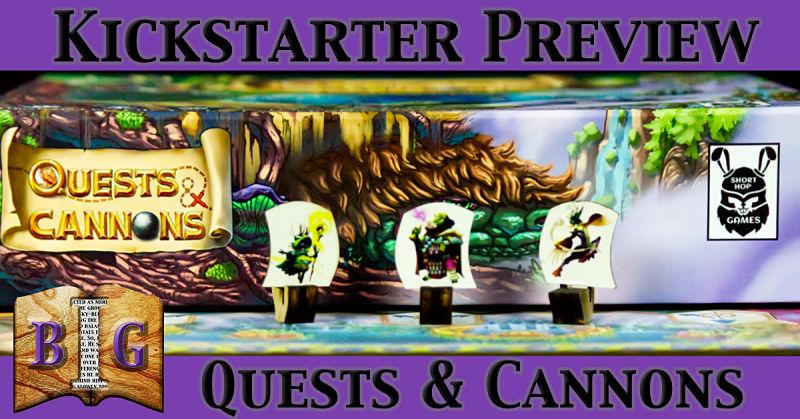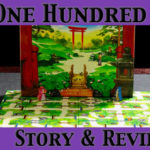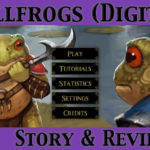Quests & Cannons is live on Kickstarter on September 21, 2021!
Designers: Eric Geller, Shannon Geller
Publisher: Short Hop Games
Artists: Unnamed
Player Count: 1-6
Editor: Unnamed
Suggested Age: 14+ (I recommend 10+)
Playing Time: 20 minutes per player
Theme: Nautical, fantasy
Mechanics: Action points, pickup and deliver, take-that, teams, variable player power
Note: I received a prototype copy of Quests & Cannons: The Risen Islands for the purpose of review. All opinions are my own. Quests & Cannons launches on Kickstarter in September 2021.
Intro Story: Load the Cannons
It takes a lot to startle Kerris Thornfur, but the red tentacles that burst from the choppy sea was enough to unsettle even the most stubborn Porc. Kerris regained her composure quickly, unwilling to let anyone see her concern. As the Dwunny chosen to explore these newfound isles, it wouldn’t do to show weakness. That would just give the Porcs and Delves the upper hand, as their races were also intent on capitalizing the new resources.
“Fire!” Kerris shouted.
The ship rumbled as, below her, three cannons fired into the writing arms of whatever lay below. All three shots hit, but the tentacles came closer to the ship. Kerris shook her head in disbelief.
“Full sails!” she called, hoping to outrun the creature. With one sail already doing its job, the two other sails unfurled and the wind caught them, pushing the ship forward. It gained speed as it cut through the water. Maybe they could outrun this thing after all.
Kerris was nearly rocked off her feet as the boat lurched to a stop. She picked herself up and saw that three tentacles had grabbed hold of the ship and was pulling it back. With a jolt that sent Kerris flying, the tentacled creature hurled the ship backward. It soared over the water as it skimmed the surface and, by some miracle, didn’t capsize when it crashed into the water. It rolled, but kept its bearing and righted itself, tossing her and her crew to and fro across the deck. One deckhand fell overboard.
After recovering the drenched sailor, Kerris stood straight-backed and looked her crew in the eyes. “I guess it wasn’t too thrilled with our cannons.” The crew laughed loudly, and she was certain it was because of the tension still lingering in the air. “But we have other problems to address at present.”
Kerris looked out over her crew and nodded into the distance. A ship, now small in the distance, was coming their way. She wasn’t aware of any other Dwunny ships scheduled to be in this part of the water, so it was either the Porcs or the Delves. Either way, it wasn’t a good sign. But there was no way she was letting anyone rid her of her precious cargo, the spoils from the newly risen isles. With the ship crippled from the sea monster, however, outrunning the incoming ship was out of the question.
“Load the cannons,” she told her crew, “and prepare for combat.”
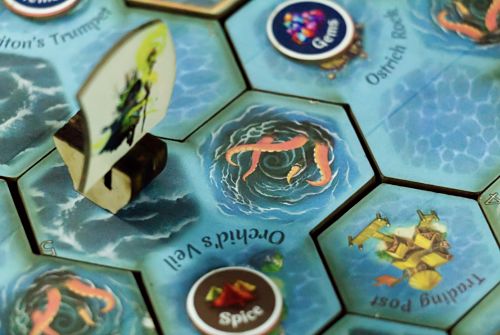
Overview/Roadmap
This review has two parts. First, there is the Short Review, where various aspects of the game are discussed. Then comes the Gameplay Review, in which the setup and gameplay are discussed in detail, along with initial thoughts. Following the Gameplay Review section are some final thoughts and a final verdict of the game. Feel free to jump around, or read it all in one go.
Short Review
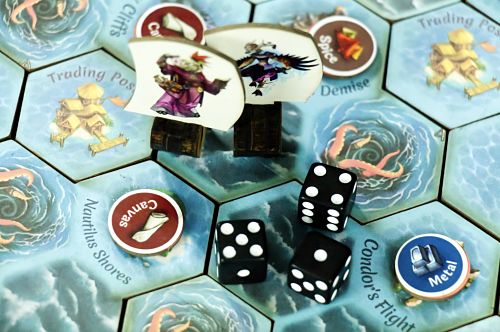
Quests & Cannons: The Risen Islands is a pick-up-and-deliver game set on the high seas of the mythical world of Miraheim. Throughout the game, players set sail to explore islands and gather resources from said islands, complete quests, follow clues, and take shots at opponent ships if they get too close (of if you get close enough). At 20 minutes per player, Quests and Cannons is a fairly light-weight game but still allows players to decide their own fates. Players control a ship captained by a unique character with unique abilities, so knowing how to capitalize on that can win you the game. While Board Game Geek suggests an age of 14+, our game group believes 10+ to be a more accurate age range, which consensus I agree with. Ready to learn more? Let’s dive into it!
Immersion
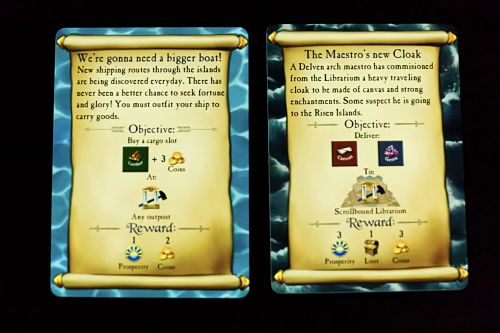
Quests & Cannons has a solid backstory with lots of flavor text on cards. Not only that, the gameplay itself plays nicely with said flavor text, which allows for an immersive experience. Likewise, when you get a group that is into it, everybody’s turn is fun and exciting. We played one game with two youth, the youngest about 12 years old. According to his father (who is a regular in our game group), “I have never seen [NAME REDACTED] wait so patiently for his turn before.” That right there is a testament to the game’s overall immersive and enjoyment factor. But it’s not just a kid’s game; the adults I played with also enjoyed it.
Theme
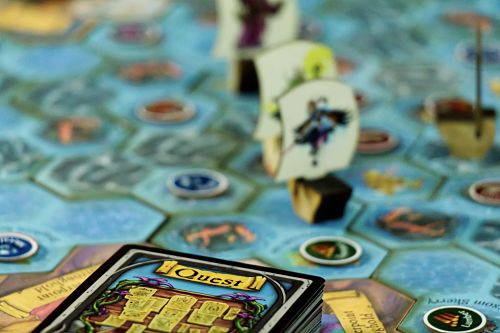
The theme is set in a fantasy world in the age of merchant ships (or pirate ships, depending on how you choose to play). The creatures in the world are a mix of your typical fantasy races (dwarves, elves, and orcs) and animals we know and love (bunnies, pigs, and ducks). Mashed together, the Dwunnies, Porcs, and Delves are certainly interesting. The theme fits the game’s mechanisms well, with quests for players to complete (i.e. by delivering goods) and enemies to blow out of the water. It’s a strong theme, and everything fits nicely together. And if you want even more theme, then don’t forget to read the flavor text!
Art & Components
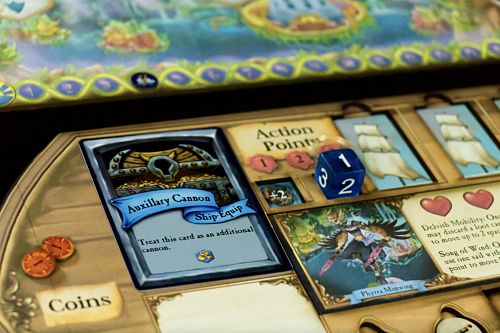
I was given a prototype copy to play, so I can’t necessarily comment on everything. However, the art looks pretty much final, and it got a lot of compliments. It’s colorful and looks like it will be a pleasure to look at once the final production copy starts hitting backers. The components are pretty great for a prototype. The player boards (the ones that look like ships) are thick, dual-layered cardboard. I appreciate the dual-layered boards, as it kept your various components where they’re supposed to be, rather than sliding around with each wave.
The sails for the little wooden ships looked cool, and helped differentiate the various characters, but they could have the adverse effect of blocking players’ vision when looking for particular islands and resources. Not a game breaker by any means, but I felt I should mention it. Likewise, sometimes it could take a moment to pinpoint your own ship amidst the throng of others. But, again, super minor thing that I’m only mentioning for the sake of transparency.
But, as a prototype, I was very impressed, as were the others I played with. The board map is also made up of various tiles, so the map’s layout can change game from game. Modular boards are fun!
Standout Performances
- Highly immersive gameplay
- Strong theme
- Modular board
- Simple rules
- Fun for kids and adults alike
- Upgradable ships
Breaking the 4th Wall
In theater, breaking the fourth wall refers to when characters (or something else) directly address the audience, thus pulling them out of the narrative and making the astutely aware that they are, in fact, watching a performance and that’s it’s not actually real.
I don’t have a lot of beef with Quests and Cannons, however I noticed the masts on the ships can block your view, especially on a crowded board. That might change in production though, so it’s pretty tough to tell in a prototype. The other thing I noticed that I haven’t mentioned yet is the size of the hexes. They can fit two ships comfortable, or three ships uncomfortable. After that, if someone else wants to join the party, there may not be room. We only had a maximum of three ships on one tile once or twice, and that was in a six-player game, so it may not be all that common, but it is something that made traversing the waters and islands more difficult for those few times it occurred. Again, it’s such a minor thing that I hesitated bringing it up. But it was still fun to clump them up and then have a shootout. *ka-boom!*
All that said, those are minor things and didn’t affect our enjoyment of the game at all. But it’s always good to know about these things going into it.
Gameplay Review
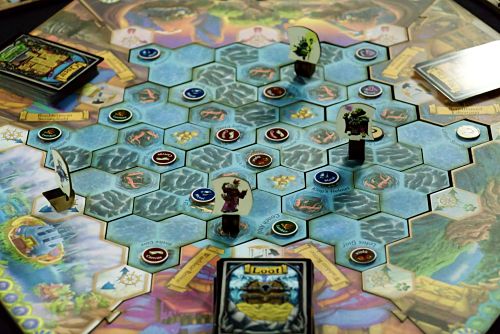
First Impressions
My first impressions were, “Cool!” when opening the box for the first time. I love a game with hexes and modular boards, so I was excited to see what it had to offer. As this was a prototype, I’m usually not expecting anything fancy, but I was pleasantly surprised with the quality of this one! Needless to say, I’m excited to see how it improves after being fully produced. The rules were simple enough to understand, but the first time I put the map together, it did take some time. It didn’t keep me from wanting to play again after though, and the second time was much faster. In all, after setup and playing, my first impressions were nothing but good.
Setup
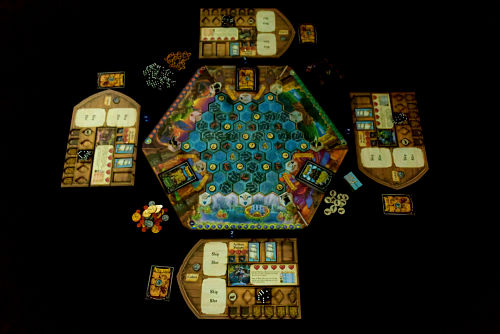
As mentioned in the First Impressions, setup might take a bit longer than it normally would on your first go. After that, though, it’s pretty quick. The board is what takes the most time, as you’ve gotta follow the setup instructions; otherwise, the map may be a wee bit unbalanced. They way they have it worked out is there are three groups of seven tri-hex tiles, each numbered 1-7. As long as you have any of the #1 tiles where the #1 shows in the setup, you’re good. Once you organize the tiles into three groups of 7, setup isn’t so bad.
Each player also takes a character board, which has its starting upgrades (i.e. sails, cargo spaces, cannons). Each character starts with different amounts of each upgrade, so just follow the starting value.
Gameplay
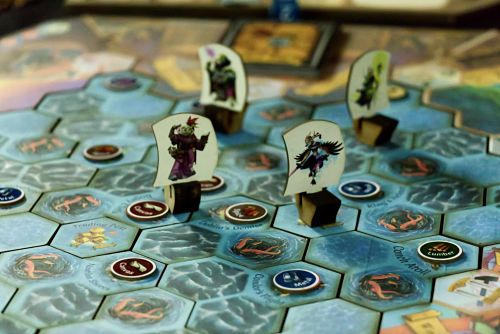
Straight to the point: I think the gameplay has a quick pace, interesting decisions, and is, above all, fun.
Quests & Cannons is a game with two main mechanisms: pickup and deliver, and take-that. The pickup-and-deliver mechanism has players drawing quest cards and then collecting goods and resources and delivering them to certain locations. This gives points, loot (i.e. upgrades), and money. The take-that mechanism involves rolling dice in an attempt to blast opponents out of the water. Deal at least one damage to get a point, and get three points for sinking an opponent’s ship. While some character powers may be better for trading or blasting, it’s nice that there are a couple of ways to get a good amount of points. Players can also get points by spending an action at a specific island to complete their clue card. Since that’s just one point, it’s not a huge priority, but it can certainly help.
The game starts off calm and peaceful, as players start exploring islands. At first, each island has a question mark token on it. But, once players stop on those islands, they get a coin for being the first to explore the island, and the question mark flips over to reveal the resource found on that island. Players also get a quest card every time the end a movement on an island.
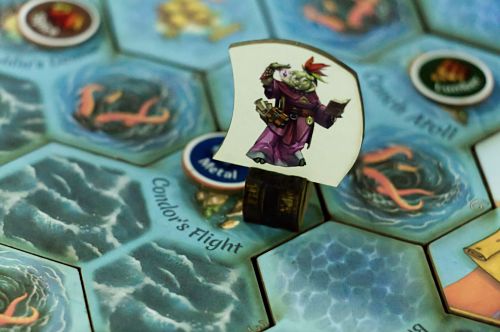
While the hand limit for quest cards is three, being able to draw a card at each island makes it possible to cycle through and find the quest cards that are easiest to accomplish—or the ones that give the most points. We had one player suggest that the draw of quest cards was too random, which could make a player lose (he was talking about himself). While I can see his point, I think one of the main ideas of the quests is to cycle through them until you get ones that are easy (or, at least, easier) to accomplish. After all, you collect a quest card at each island, and there are plenty of islands, so cycling through isn’t too difficult. I learned to do that after my first play, and I’ll tell you, it did make completing quests easier.
The combat is interesting as well. Each player has a certain amount of cannons on their ship, which is the amount of ammo dice they can roll during combat. Once used, ammo dice are returned to the main supply, but can be purchased at the amazingly cheap price of one point for two ammo dice. Of course, you can only use each cannon once per turn, but they do refresh at the start of your next turn. I really like the way hits are determined. When dealing damage, check your total dice results, and every 4 pips on the dice is a hit. So, when rolling just two dice, it’s still possible to deal 3 damage by rolling two sixes (because 12 is 3×4). It means that even though you roll a two on one die, you can still deal damage by rolling at least a two on another die. It’s a great way to do it.
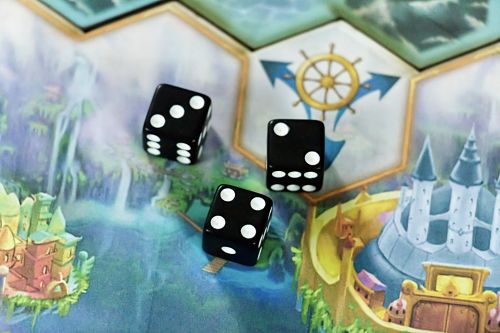
Sailing across the ocean can be slow going at first, but by upgrading and buying more sails, you’re able to travel faster. Each Move action moves your ship one space. But, if you use a sail, you can move an extra space with that action. By using multiple sails on one Move action, you can travel pretty far.
There is also a certain sea space that can potentially help you get even further on your Move action. This is the treacherous water space, as indicated by the tentacles emerging from the depths. If you sail into that space, you roll a die. On a result of 1-3, you take a damage. But, on a 4-6, you get shot out of that space to an adjacent space of your choice. It’s a gamble, but it can be well worth it. If you do fail, your next die roll gives you a +1 bonus. If you fail your next treacherous water roll, you get a +2 bonus to your next roll. If you fail after that, then maybe you should stop rolling a 1 every time…
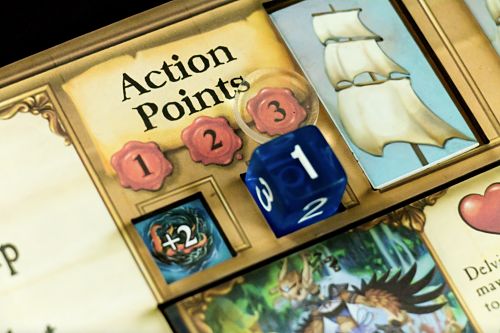
The game ends when one player reaches 15 points. After that, each player that hasn’t taken a turn that round takes one final turn, and the game ends. The player with the highest score wins, and money is used as a tie breaker.
The rules discussed above are for the free-for-all mode, but there is also a solo variant as well as team rules. The gameplay for teams is essentially the same, but the end-game score condition is increased depending on the player count. Teams provides the option to divide and conquer, where one player takes the roll of the pirate and sinks ships, while the other completes quests. Or they can travel together for protection, questing and sinking as they please.
Thoughts on Gameplay
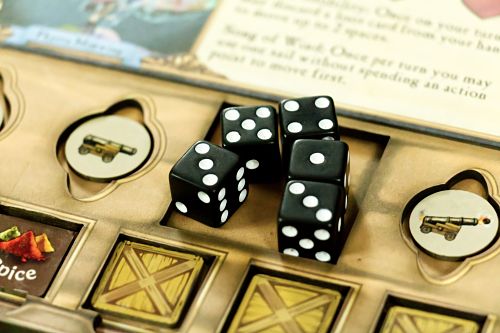
I really enjoyed playing Quests & Cannons. The turns went quickly, and the rules were pretty simple. That said, I still felt like there were enough decisions to make the game interesting. As far as strategy goes, it is on the lighter side of things, so don’t expect to have to juggle a lot of things at once. Still, there were plenty of options, some risky and some safer, and I was quite pleased with how it all went down.
I think the game shines with more players, as it forces more player interaction and makes the figurative walls close in more. Fewer players is also fun, but it can feel like a different game, as players can more easily avoid each other if they want. But maybe that’s the way you prefer to play. Personally, I like the chaos of a crowded ocean where you don’t know if you’ll be attacked or if Jimmy is just passing by.
Speaking of crowded seas, the hexes can feel a bit cramped if more than two boats are on the same one. This didn’t happen often—maybe once or twice in a six-player game—but it did’t look comfortable when it did. The hexes just didn’t have room for that many ships; however, as ships tend to always be on the move, this wasn’t a frequent occurrence, and when it did happen, the congestion subsided quickly enough. Plus, it was rather hilarious to have that many ships in the same spot, as they all threatened each other with cannonballs.
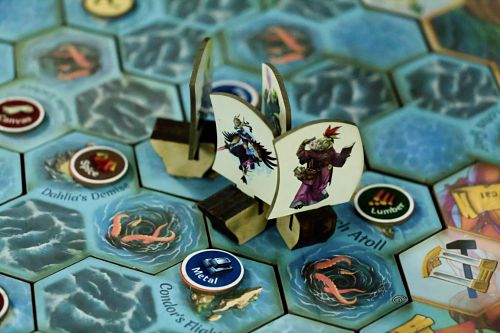
And that’s another aspect I loved about Quests & Cannons. The banter it created was absolutely wonderful. The time between turns had players talking and cajoling with each other with fair promises and/or threats. Some games require players to focus on their next turn while others take theirs, but we found Quests & Cannons provided a bit of reprieve in that area, as we laughed and joked as others took their turns, and when it came back to us, we still knew what was going on. I found it to be a very social game, and I think that’s what gave it a lot of its charm.
Solo Play
As mentioned, Quests & Cannons can be played solo. The rules don’t change for the player, other than you have a certain number of rounds to reach your 15 points. The dummy players (or automa or AI or whatever you want to call them) are mostly stationary, but will come after you if you get too close. Their range is determined by their cannons. So, if the AI ship has two cannons and you end your turn within two spaces of that ship, it will come at you and initiate an attack. After five rounds all ships gain another cannon, and then a fourth cannon at 10 rounds. By that point, there’s really no safe place to travel, as you’ll most likely be within range of at least one ship at the end of each turn.
The solo variant plays quickly, as it’s just you sailing about with nary a care in the world (except those automa ships). Solo play may not be as exciting as multiplayer games, but it’s still a fun jaunt across the ocean and all that entails. Because it plays pretty quickly, this is one I’d play a few times in a row solo.
Final Thoughts
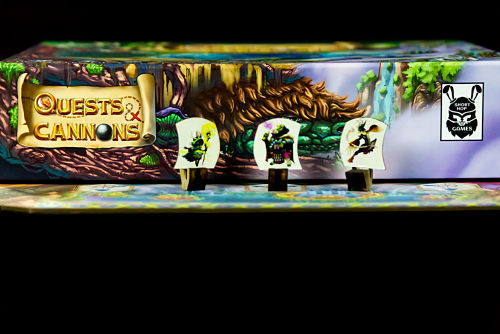
Welp, if you’ve read the entire review, I think you’ll have a good idea of where I stand. Quests and Cannons is a fun game. I like it. It’s lightweight in terms of strategy, but not so light that it’s mind-numbingly dull. The choices are interesting, and you can expect some resistance at the hands of the other players, which always seems to spice things up.
The banter between (and during) turns is a boon to the game, as players aren’t afraid to take their eyes off their strategy for a moment (it’s not going anywhere, after all). I’m not suggesting that all game groups are going to have the same fun banter we had while playing, but the possibility is there.
Final Verdict
This is what it all boils down to, the final verdict. Is it good? Yes indeed. Is it for everyone? Probably not. Fans of heavy games might find Quests and Cannons too light for their liking. And that’s OK. But there is a certain group that this game is practically perfect for, and that is those who prefer a more casual game that still feels immersive and engaging. The rules are simple, but it’s not mundane. I took a very unofficial poll after our last game, and, out of a possible ten, we had people rate if anywhere from 7 to 9. That’s a pretty good range.
Personally, a nine might be a little too generous for me, but for he who rated it as such, he meant it with all his heart. Isn’t that wonderful? I just love how people have different opinions on these things, and that one person’s 9 is a very enjoyable 7 for someone else. Fortunately, I don’t do ratings out of 10, so we’ll have a different rating here.
With everything considered—solo play, fun factor, immersion, enjoyment both during and after (talking about it, etc.)—it’s time to stick it all in a blender and see what we come up with. I consider a rating of Two Thumbs up to be a good, supportive rating. Quests and Cannons doesn’t break any molds, but it doesn’t grow moldy, either. In the end, I give it a rating of Two Captivating Thumbs. It is very enjoyable, easy to grasp, and produces good vibes around the table.
Remember, this is my personal rating. As I mentioned, someone else might give it a rating of Captivating or Standing Ovation (in fact, I would bet my hard-earned money on it, if I were a betting man). From what you read in this review, you be the judge. Regardless, Quests and Cannons is a fun-filled adventure on the high seas where quests are plenteous and the cannons are intimidating. There’s a lot to love about Quests & Cannons, and it’s hard to argue with a game that sucks you right into its gameplay with smiles and laughter all around the table.
Lastly, on their Facebook page, Short Hop Games describes themselves as a game company that “create[s] games that provide depth of gameplay and are intuitive to learn, ideally suited for gamers of all skill levels.” If you’re looking for a game just described, Quests & Cannons is that game.
Quests & Cannons is live on Kickstarter on September 21, 2021!
Visit Short Hop Games on Facebook, Instagram, Twitter, and at their website.
Verdict Scale (Lowest to Highest)
The Final Verdict is based on a scale of 1-7, although this scale is not numbered. Instead, it uses thematically appropriate words to describe the performance of the game.
Tomatoes – This game was emotionally taxing and difficult to finish.
Uninspiring – This game had me daydreaming about other games.
Lackluster – This game had its moments, but it probably won’t see much table time.
Laodicean – This game is decent. It works. There’s a reason people like it.
Two Thumbs Up – This game is pretty dang good.
Captivating – This game is outstanding! It’s more than good; it’s practically a staple.
Standing Ovation – This is the best game you will ever play. Period.
Read short fiction inspired by board games at BGI’s stories page!
Visit Short Hop Games on Facebook, Instagram, Twitter, and at their website.

